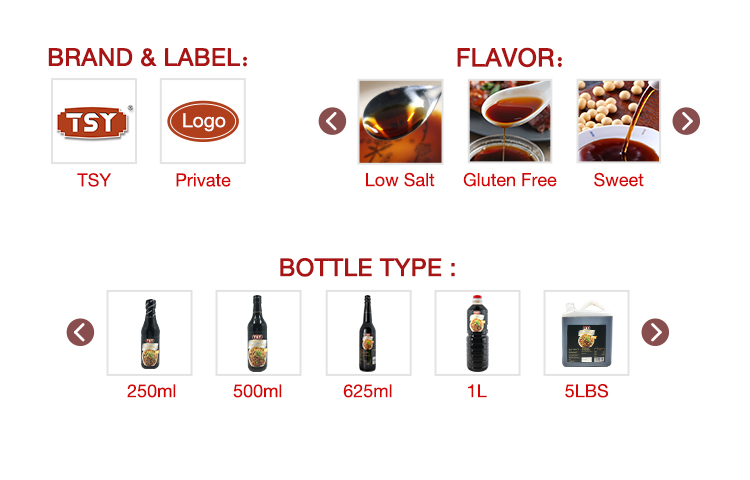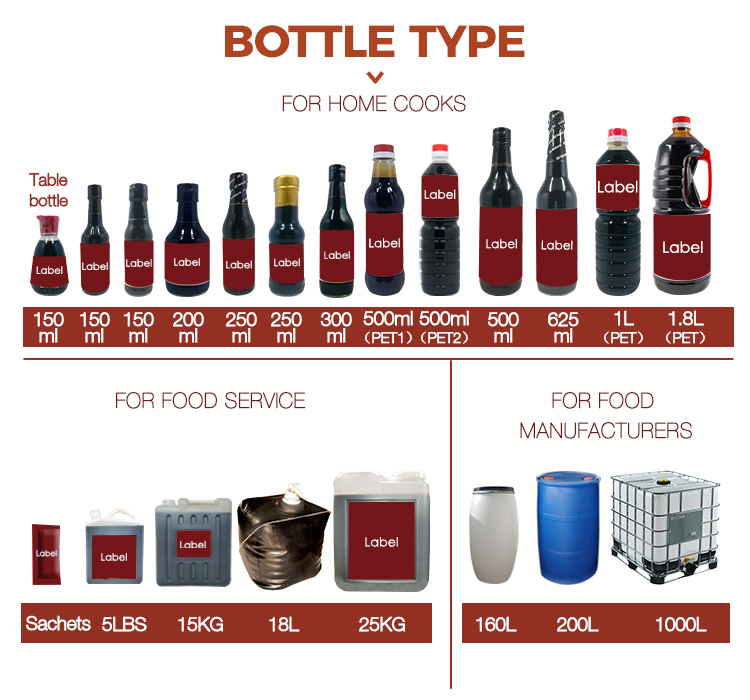TSY or Custom Brands
| Availability: | |
|---|---|
| Quantity: | |








| Appearance | It maintains a similar appearance to traditional soy sauce, being dark brown and liquid. |
| Flavor | In terms of taste, it retains the fundamental umami flavor but with a milder and less salty profile. |
| Ingredient | Water, Soya Bean, Salt, Wheat Flour, Sugar, Monosodium Glutamate(E621), Potassium Sorbate(E202). |
| Serving Suggestion | Low-salt soy sauce is versatile in various dishes. Use it as a seasoning for stir-fries, marinades, and dressings to impart a milder, umami flavor. It's an excellent choice for those watching their sodium intake. Consider using it in moderation as a dipping sauce or as a substitute in recipes that call for regular soy sauce. |
| Nutrition information typical values per 100g | Energy 126kJ/30Kcal Protein 4.5g Total fat 0g Carbohydrate 2.9g Sodium 4425mg |
| Shelf Life | 24 months |
| STORAGE: | Keep at room temperature and moisture proof storage. Please closed After opening use,and store in dry cool place. |
| Certificate | HACCP, BRC, IFS, HALAL, KOSHER, ISO |
Low-sodium soy sauce offers the same umami flavor as regular soy sauce but with reduced sodium content. This can be beneficial for those watching their salt intake, helping to lower blood pressure and reduce the risk of cardiovascular issues. It's also a good option for people with certain health conditions, like hypertension or kidney problems, who need to limit their sodium consumption.
Low Salt Soy Sauce can be used in the same way as regular soy sauce, though you might need to adjust the amount depending on the dish and your taste preferences. Here are some common uses:
Marinades: Use it to marinate meats, fish, and vegetables before grilling or stir-frying.
Stir-Fries: Add it to stir-fries for a savory flavor.
Dipping Sauces: Mix it with other ingredients like sesame oil, garlic, and ginger to create delicious dipping sauces.
Soups and Stews: Enhance the flavor of soups and stews by adding a splash of low salt soy sauce.
Sauces and Dressings: Use it in salad dressings, sauces, and gravies to add depth and umami.
Low-salt soy sauce means soy sauce with reduced salt content, usually less than 9 grams per 100 grams. This soy sauce is suitable for hypertensive patients and patients with generalized edema who need to limit their sodium intake, because regular soy sauce is difficult to achieve the desired control effect even with proper moderation .
Manufacturing process
The production process of low-salt soy sauce mainly includes steaming, making koji and fermentation. Using defatted soybeans and wheat bran as raw materials, after steaming and making koji with Aspergillus, they are mixed with low-salt brine for solid-state fermentation. Compared with high-salt liquid-state fermentation, low-salt solid-state fermentation has a higher temperature and shorter time, and thus a shorter brewing cycle. Although the fermentation period is short, the low-salt solid-state fermented soy sauce is darker in color, with simple enzymatic hydrolysis of protein, looks appetizing, though slightly inferior in flavor and aroma .
Advantages :
Short fermentation cycle : can produce quickly.
Dark color : Has an advantage in appearance.
Less additives : Simple ingredients, healthier.
| Appearance | It maintains a similar appearance to traditional soy sauce, being dark brown and liquid. |
| Flavor | In terms of taste, it retains the fundamental umami flavor but with a milder and less salty profile. |
| Ingredient | Water, Soya Bean, Salt, Wheat Flour, Sugar, Monosodium Glutamate(E621), Potassium Sorbate(E202). |
| Serving Suggestion | Low-salt soy sauce is versatile in various dishes. Use it as a seasoning for stir-fries, marinades, and dressings to impart a milder, umami flavor. It's an excellent choice for those watching their sodium intake. Consider using it in moderation as a dipping sauce or as a substitute in recipes that call for regular soy sauce. |
| Nutrition information typical values per 100g | Energy 126kJ/30Kcal Protein 4.5g Total fat 0g Carbohydrate 2.9g Sodium 4425mg |
| Shelf Life | 24 months |
| STORAGE: | Keep at room temperature and moisture proof storage. Please closed After opening use,and store in dry cool place. |
| Certificate | HACCP, BRC, IFS, HALAL, KOSHER, ISO |
Low-sodium soy sauce offers the same umami flavor as regular soy sauce but with reduced sodium content. This can be beneficial for those watching their salt intake, helping to lower blood pressure and reduce the risk of cardiovascular issues. It's also a good option for people with certain health conditions, like hypertension or kidney problems, who need to limit their sodium consumption.
Low Salt Soy Sauce can be used in the same way as regular soy sauce, though you might need to adjust the amount depending on the dish and your taste preferences. Here are some common uses:
Marinades: Use it to marinate meats, fish, and vegetables before grilling or stir-frying.
Stir-Fries: Add it to stir-fries for a savory flavor.
Dipping Sauces: Mix it with other ingredients like sesame oil, garlic, and ginger to create delicious dipping sauces.
Soups and Stews: Enhance the flavor of soups and stews by adding a splash of low salt soy sauce.
Sauces and Dressings: Use it in salad dressings, sauces, and gravies to add depth and umami.
Low-salt soy sauce means soy sauce with reduced salt content, usually less than 9 grams per 100 grams. This soy sauce is suitable for hypertensive patients and patients with generalized edema who need to limit their sodium intake, because regular soy sauce is difficult to achieve the desired control effect even with proper moderation .
Manufacturing process
The production process of low-salt soy sauce mainly includes steaming, making koji and fermentation. Using defatted soybeans and wheat bran as raw materials, after steaming and making koji with Aspergillus, they are mixed with low-salt brine for solid-state fermentation. Compared with high-salt liquid-state fermentation, low-salt solid-state fermentation has a higher temperature and shorter time, and thus a shorter brewing cycle. Although the fermentation period is short, the low-salt solid-state fermented soy sauce is darker in color, with simple enzymatic hydrolysis of protein, looks appetizing, though slightly inferior in flavor and aroma .
Advantages :
Short fermentation cycle : can produce quickly.
Dark color : Has an advantage in appearance.
Less additives : Simple ingredients, healthier.
TSY Foods provide different products quality needs, and we can customize products according to customer requirements.


SPECIFIATION PER CTN | BOTTLE TYPE | CTNS/20'GP |
150ml*12btls/box*4boxes | Glass bottle | 1010 |
150ml*24btls | Table bottle | 1855 |
200ml*24btls | Glass bottle | 1550 |
250ml*24btls | Glass bottle | 1550 |
300ml*12btls | Glass bottle | 1550 |
500ml*12btls | Glass bottle | 1550 |
625ml*12btls | Glass bottle | 1330 |
1000ml*12btls | Plastic bottle | 1224 |
1.86L*6jar | Plastic jar | 1400 |
5L*4jar | Plastic jar | 756 |
8L*2jar | Plastic jar | 1150 |
18L*1bag/box | Faucet soft bags | 1008 |
15kg*2drum | Plastic drum | 700 |
25kg*1drum | Plastic drum | 800 |
160L*1drum | Plastic drum | 100 |
200L*1drum | Plastic drum | 80 |
1000L*1drum | Plastic drum | 20 |
* If you have other needs, please consult us.

TSY Foods provide different products quality needs, and we can customize products according to customer requirements.


SPECIFIATION PER CTN | BOTTLE TYPE | CTNS/20'GP |
150ml*12btls/box*4boxes | Glass bottle | 1010 |
150ml*24btls | Table bottle | 1855 |
200ml*24btls | Glass bottle | 1550 |
250ml*24btls | Glass bottle | 1550 |
300ml*12btls | Glass bottle | 1550 |
500ml*12btls | Glass bottle | 1550 |
625ml*12btls | Glass bottle | 1330 |
1000ml*12btls | Plastic bottle | 1224 |
1.86L*6jar | Plastic jar | 1400 |
5L*4jar | Plastic jar | 756 |
8L*2jar | Plastic jar | 1150 |
18L*1bag/box | Faucet soft bags | 1008 |
15kg*2drum | Plastic drum | 700 |
25kg*1drum | Plastic drum | 800 |
160L*1drum | Plastic drum | 100 |
200L*1drum | Plastic drum | 80 |
1000L*1drum | Plastic drum | 20 |
* If you have other needs, please consult us.

Low-salt soy sauce generally contains similar nutrients to regular soy sauce, but with reduced sodium content. It's a source of amino acids, protein, and small amounts of vitamins and minerals. However, nutrient content can vary between brands. It's a good idea to check the label for specific nutritional information.
Low-salt soy sauce is a versatile condiment suitable for various culinary applications. Its reduced sodium content makes it a healthier alternative without compromising flavor. Use it as a seasoning in stir-fries, marinades, soups, and sauces to add depth without excessive salt. Additionally, it works well as a dipping sauce for sushi, dumplings, or as a flavorful drizzle on steamed vegetables. Experiment with incorporating low-salt soy sauce into your favorite recipes for a balanced and heart-friendly option.
Low-salt soy sauce generally contains similar nutrients to regular soy sauce, but with reduced sodium content. It's a source of amino acids, protein, and small amounts of vitamins and minerals. However, nutrient content can vary between brands. It's a good idea to check the label for specific nutritional information.
Low-salt soy sauce is a versatile condiment suitable for various culinary applications. Its reduced sodium content makes it a healthier alternative without compromising flavor. Use it as a seasoning in stir-fries, marinades, soups, and sauces to add depth without excessive salt. Additionally, it works well as a dipping sauce for sushi, dumplings, or as a flavorful drizzle on steamed vegetables. Experiment with incorporating low-salt soy sauce into your favorite recipes for a balanced and heart-friendly option.